Nusa Penida & Lembongan-Ceningan Dive Sites
-Map & Dive Description-
Nusa Penida – Diving Spots, Dive Map, Dive Sites POI
Nusa Penida – Diving Spots, Dive Map, Dive Sites POI
Explore the spectacular underwater world of Nusa Penida, Nusa Lembongan, and Nusa Ceningan – three islands just off the southeast coast of Bali. This region is famous for world-class diving: graceful manta rays, exciting drift dives, vibrant coral reefs, and the seasonal arrival of the famous Mola Mola (ocean sunfish).
With over 25 dive sites across different zones (West, North, Central, East & Lembongan), there’s something for every level of diver. From easy coral slopes to challenging drift dives and pelagic-rich drop-offs, the Nusa Islands offer some of the most exciting diving in Indonesia.
At Bali Aqua Dive Center Sanur, we organize daily dive trips to Nusa Penida by speed boat. We choose dive sites each day based on sea conditions, your experience level, and what you’re hoping to see (Manta Point – Crystal Bay – and a drift dive). Whether you’re a beginner or a certified diver seeking a close encounter with Manta rays or Mola Mola, this area has it all.
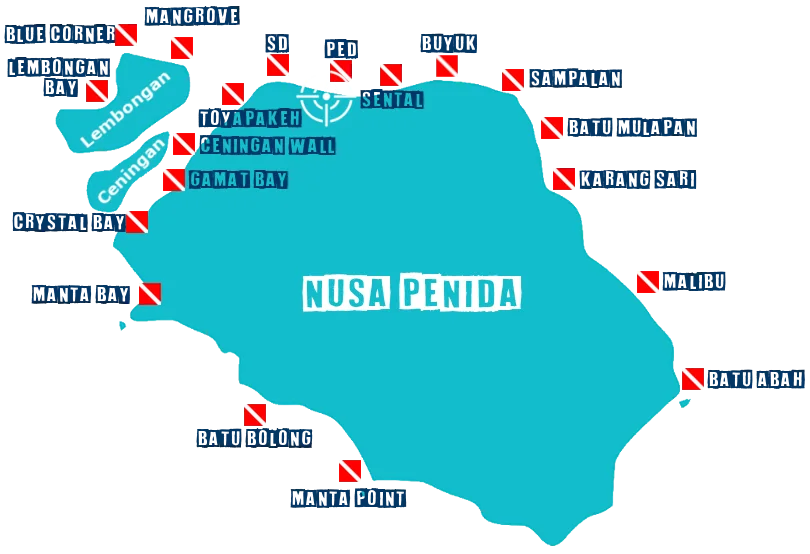
The Nusa Islands—Penida, Lembongan, and Ceningan—offer a rich diversity of dive experiences spread across different zones. For easier navigation and planning, we’ve grouped the dive sites into five key areas. Each region has its own unique characteristics, marine life, and dive conditions.
The west coast of Nusa Penida is the most well-known diving area on the island. It’s home to legendary dive sites like Manta Point, where manta rays can be seen throughout the year, and Crystal Bay, one of the top places in the world to see the Mola Mola (ocean sunfish) during the season from July to October. You’ll also find dive sites like Manta Bay, which is mostly visited by snorkelers, and Batu Bolong, a rarely accessible site due to strong currents and its technical difficulty. These dive sites can be challenging, so it’s important to dive with experienced guides.
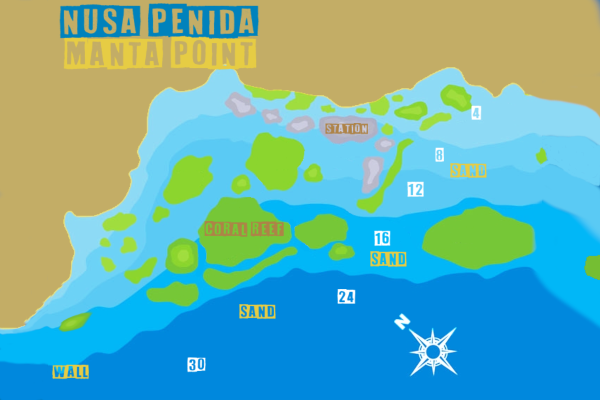
Manta Point in Nusa Penida is one of the most iconic dive sites in Bali. It’s famous for its manta ray cleaning station, where reef manta rays (Mobula alfredi) gather to be cleaned by small fish. Manta rays are commonly seen here all year round, gracefully circling divers at close range. The site also offers interesting marine life such as nurse sharks, blue-spotted stingrays, and occasional macro critters like nudibranchs. The underwater scenery includes a rocky plateau with boulders and coral, followed by a small wall that slopes into the deep. This deeper wall area, more suited to experienced divers, is a great place to watch for Mola Mola during the season.
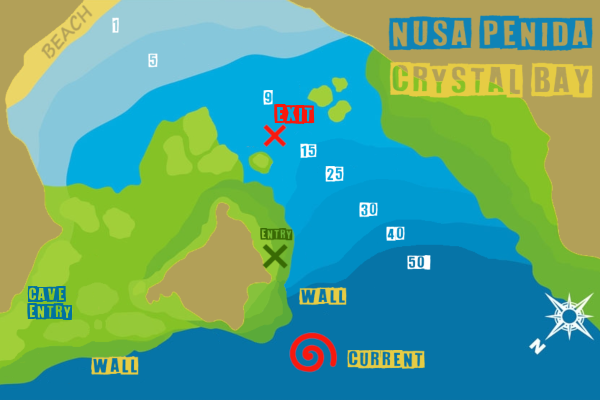
Crystal Bay is one of Bali’s most famous dive sites, especially during Mola Mola season (July to October). Divers visit hoping to spot this unique ocean sunfish as it comes into shallower water to interact with cleaner fish such as Moorish idols. Even when it’s not Mola season, Crystal Bay offers a beautiful coral reef, a sandy bay with great visibility, and the chance to encounter large marine animals.
The site features a sloping reef and a deeper drop-off, where currents can be tricky and sudden. It’s important to dive here with an experienced guide who understands the timing and flow of the currents. Crystal Bay has also delivered rare and memorable sightings such as thresher sharks, dolphins, large schools of barracuda, giant trevally, and even whale sharks.
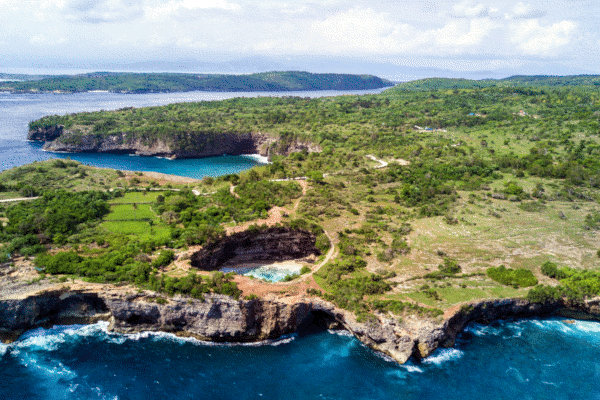
Often confused with Manta Point, Manta Bay is at closer distance and mainly used for snorkeling. It offers occasional sightings of smaller manta rays but tends to be crowded with boats and snorkelers. It’s a relaxed dive site with coral gardens and gentle conditions, best suited for beginners or snorkel trips.

Also known as “Donut” due to its name meaning “Pierced Rock” in Indonesian, Batu Bolong of Nusa Penida is an impressive but rarely visited dive site. It’s only accessible when the sea is perfectly calm and is recommended for very experienced divers. The dive site features a wall section and a plateau, with strong and unpredictable currents that require expert navigation.
Marine life here includes schooling fish, reef sharks, barracuda, eagle rays, and sometimes even Mola Mola during the season. Due to the site’s exposure and technical difficulty, it is reserved for expert-level dives only.
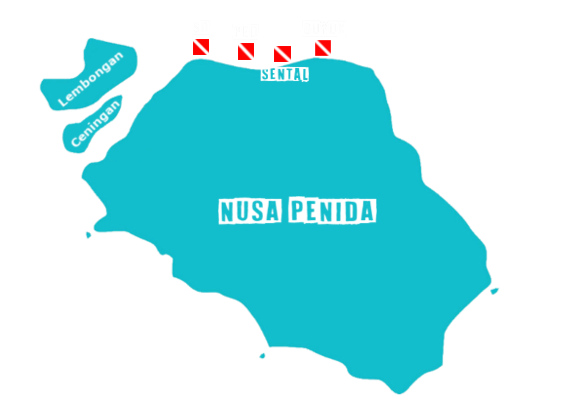
The north coast of Nusa Penida is home to some of the most accessible and rewarding dive sites on the island. Sites like SD, PED, Sental, and Buyuk line up along this stretch, creating a perfect drift diving zone. Thanks to the sloping reefs and consistent current, you can often start at one site and end your dive at the next. This region is also more sheltered from the southern swell, making it a reliable choice when conditions elsewhere are rough.
Drift along colorful coral slopes filled with reef fish, turtles, and macro life – and don’t forget to keep an eye out in the blue! Pelagic encounters are common here, including Mola Mola, giant trevally, tuna, and even the occasional whale shark. These dive sites are suitable for all levels and offer both easy shallow zones and deeper areas for experienced divers.
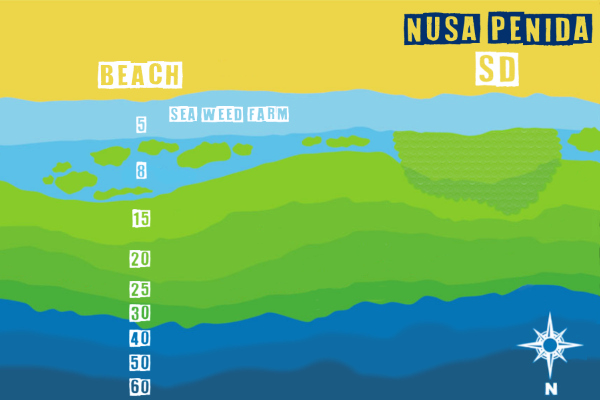
SD is one of the most popular and accessible dive sites on the north coast of Nusa Penida. The name “SD” comes from the nearby primary school (Sekolah Dasar), but for divers, it holds a different meaning—this is where the adventure begins, right in front of our Bali Aqua dive center in Nusa Penida.
The reef starts with a shallow plateau that quickly drops into a beautiful coral slope. This makes it ideal for both beginners and certified divers. The site is covered with healthy hard corals, sponges, and bustling reef life. It’s perfect for gentle dives, but when the current picks up, SD becomes an excellent drift dive, letting you glide smoothly along the slope while enjoying the vibrant underwater scenery.
Look out into the blue—Mola Mola, giant trevally, tuna, eagle rays, and even whale sharks have been spotted here during the right season. The end of the dive brings you to a calm area, perfect for a relaxed safety stop surrounded by reef fish and coral gardens.
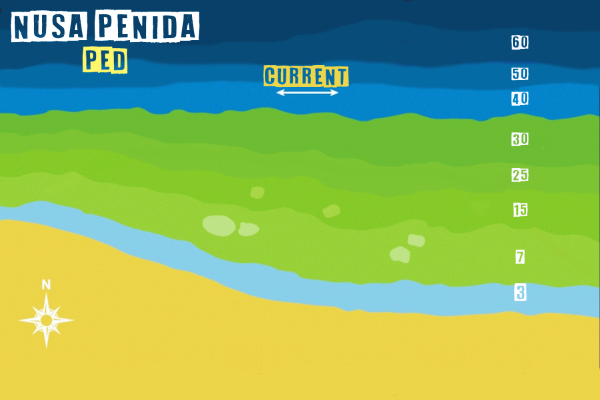
PED is located directly in front of the village of Ped temple, and it’s also the house reef of our Bali Aqua dive center in Nusa Penida. Easy access, rich marine life, and vibrant reef slopes make this one of our all-time favorite dive sites. So much that we dive it almost daily!
The site begins with a shallow plateau, quickly sloping down at a 45° angle into deeper waters. The corals here are exceptionally healthy, and the site is known for its bright sponges, soft corals, and reef fish activity. Depending on the tides and current, PED is often done as a drift dive, with the entry point adjusted by your guide for the best direction and depth.
What makes PED special is the mix of marine life—from macro creatures like nudibranchs and octopus, to pelagic encounters. During the Mola Mola season (July–October), this site becomes a prime spot for sightings. Barracudas, turtles, giant trevallies, thresher sharks, and tunas.
You’ll also find schooling yellowback fusiliers and Moorish idols hovering in the blue—often a sign that a Mola Mola may be nearby.
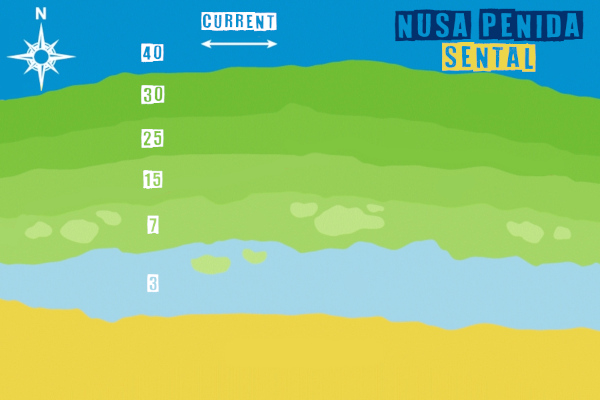
Located just east of PED, Sental continues the north coast chain of dive sites. With a slightly steeper slope and a wider coral plateau, it’s a fantastic drift dive filled with healthy coral formations, large schools of fish, and a chance to see pelagics in the deep blue.
The dive begins on the plateau, usually between 7 and 18 meters, where vibrant corals and sponges provide shelter for reef fish and macro life. As you descend along the slope, you’ll be surrounded by swirling fusiliers, groupers, butterflyfish, and more. The currents here can vary in strength, so your guide will select the best entry point and manage the drift accordingly.
What makes Sental exciting is the constant possibility of big encounters: Mola Mola, tunas, thresher sharks, barracudas, and even eagle rays have all been seen here, especially during the right season. Stay close to your guide—they know when and where to look, and how to navigate potential current changes safely.
Macro lovers can enjoy the shallower reef toward the end of the dive, where you’ll often find nudibranchs, frogfish, mantis shrimp, octopus, and turtles.
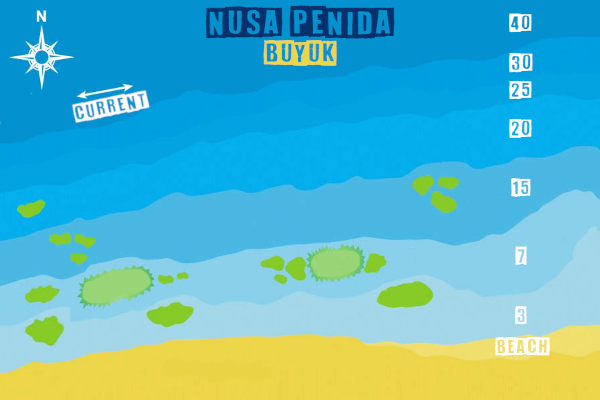
Buyuk is the easternmost dive site along Nusa Penida’s north coast and offers a slightly different underwater experience. While it still features the signature sloping reef of the north, its wide sandy plateau and gentler slope make it especially appealing to macro photographers and newer divers.
This site is often used as an entry or exit point for drift dives between Buyuk and Sental, depending on the current. The shallower areas are perfect for Discover Scuba Dives, check dives, or slow exploration dives focused on nudibranchs, octopuses, frogfish, and other hidden gems.
As you move deeper, the slope gradually becomes steeper and more similar to the neighboring sites. The blue water to the east holds the same potential for larger pelagic sightings—Mola Mola, sharks, tunas, and barracuda have all been spotted here, especially during early morning dives when boat traffic is lower.
The only downside? Buyuk is located near recently built pontoons used for tourist water activities like banana boats and jet skis. That’s why we prefer to dive here early in the morning, before the water gets too busy.
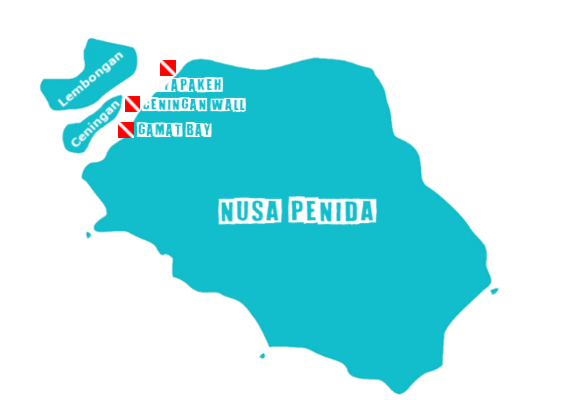
The central coast of Nusa Penida, stretching between the island’s north and west, offers a mix of sheltered bays, deep channels, and colorful coral slopes. This area is less visited than other parts of the island, making it a favorite for divers looking to explore hidden gems.
Dive sites like Toyapakeh, Gamat Bay, and Ceningan Wall each offer a unique profile—from calm coral gardens to vertical drop-offs swept by strong currents. These sites are perfect for divers who want to experience the full range of Nusa Penida’s underwater diversity, especially on multi-day dive packages.
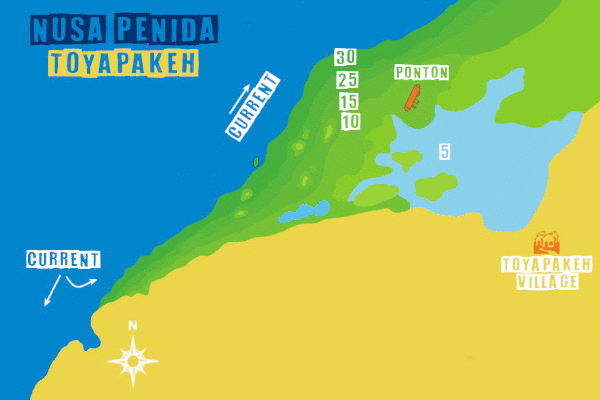
Toyapakeh is one of the most colorful and diverse dive sites in Nusa Penida. Located near the main harbor of the village of Toyapakeh, this large site offers something for everyone—whether you’re a beginner or an experienced diver. It’s a favorite among our guides for its mix of healthy coral formations, schooling fish, and the potential for big pelagic encounters.
Depending on the tide and current, Toyapakeh can be a gentle dive or a thrilling drift. The site features stepped coral terraces and a wide plateau, making it easy to adapt the dive to your level. For experienced divers, deeper areas along the slope are great spots to watch for tuna, barracuda, and even Mola Mola during the right season.
While the macro life is also interesting, Toyapakeh is best known for its wide-angle beauty and the feeling of immersion in a bustling underwater ecosystem.
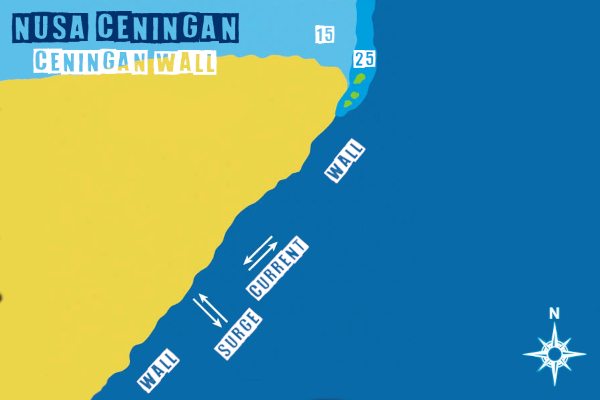
Located along the southern side of Nusa Ceningan, Ceningan Wall is a dramatic dive site featuring a deep, vertical wall covered in vibrant small hard and soft corals. It’s a spectacular location for experienced divers, especially when the current is calm enough to explore the full beauty of the site.
The wall itself drops steeply into the deep blue, and you’ll often be drifting along while surrounded by schools of fusiliers, red-toothed triggerfish, jackfish, and barracuda. On lucky days, you may even spot Mola Mola, eagle rays, or reef sharks cruising by. Macro lovers will also enjoy finding nudibranchs, shrimp, and other small critters tucked into crevices.
Due to its exposure to strong currents and occasional surge, diving here requires good buoyancy control and close attention to your guide’s briefing. When conditions are right, Ceningan Wall delivers one of the most memorable dives in Nusa Penida.
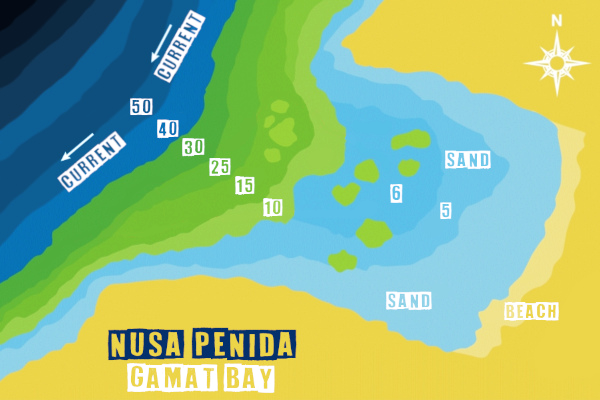
Gamat Bay is a scenic and versatile dive site tucked into a sheltered bay on the northwest side of Nusa Penida. Known for its vibrant coral gardens, sandy slopes, and diverse marine life, it’s a favorite for many divers—whether you’re a beginner, macro lover, or seasoned pro.
Inside the bay, the conditions are usually calm, making it ideal for Discover Scuba Diving, Open Water training, or leisure dives focused on macro photography. You’ll find nudibranchs, frogfish, shrimp, octopuses, and a healthy reef teeming with life.
For more experienced divers, the site also offers opportunities to explore deeper areas within the bay itself. However, it’s important to note that Gamat Bay opens into a strong channel—and drifting into that zone is generally not the goal of the dive. Your experienced Bali Aqua guide will assess sea conditions before and during the dive to ensure both safety and enjoyment. If suitable, a light drift in shallow water at the end of the dive may be considered, but only if conditions are calm and visibility is good.
On deeper sections within the bay, it’s possible to spot pelagics such as tuna, barracuda, and giant trevally, as well as occasional Mola Mola during the season.

Nusa Lembongan, a small island just north of Nusa Penida, is home to three popular dive sites: Mangrove (also known as Sakenan), Blue Corner, and Lembongan Bay. Although fewer in number compared to Penida, these dive sites offer great variety and are a fantastic addition to any Bali diving experience.
Mangrove is a classic drift dive, with healthy coral slopes, schools of reef fish, and vibrant sponges shaped by the current—perfect for divers who enjoy being carried gently along the reef. Blue Corner is well known in the diving community as one of the best sites in Bali to encounter Mola Mola (ocean sunfish) during the right season, but it also comes with strong and unpredictable currents, so it’s only suitable for experienced divers. Lembongan Bay provides a calm and shallow site with sandy bottoms and coral patches, ideal for beginner divers or training dives.
Despite their differences, all three sites benefit from Lembongan’s clear waters and rich marine biodiversity. These dives are often combined with trips to Nusa Penida, making them an exciting part of any day of diving in the Nusa Islands.
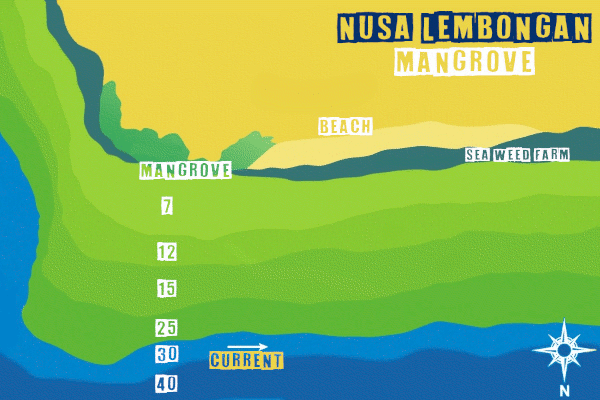
Located at the northeastern tip of Nusa Lembongan, Mangrove, also known locally as Sakenan, is one of the island’s most well-loved drift dives. The site gets its name from the nearby mangrove forest that lines the shore, marking the typical entry point. Just a short ride from Bali, this site is a great option for a third dive after visiting Manta Point or Crystal Bay.
The dive begins on a wide, shallow coral plateau filled with hard corals, soft corals, and sponges sculpted by the current. From there, the reef gently slopes down in steps, making it easy to manage depth while drifting with the flow. The scenery is constantly changing—schools of reef fish, triggerfish, pufferfish, and snappers move in and out of view, and you may even spot turtles or a passing barracuda.
As the current carries you along, you’ll pass coral bommies, valleys with sandy bottoms, and clusters of staghorn coral teeming with life. The reef is colorful and healthy, and visibility is often excellent, especially in the dry season. While it’s accessible for all certified divers, the strength of the current can vary, so your guide will choose the best entry point and adjust the plan accordingly.
Mangrove is also one of our favorite sites for drift dive specialty training. The long reef and consistent current make it ideal for learning how to control buoyancy and enjoy the ride—just like flying underwater.

Blue Corner is one of the most famous dive sites around Nusa Lembongan—and one of the most challenging. Located on the northwest tip of the island, this site is known for its deep slope, strong currents, and big fish encounters, especially the Mola Mola (ocean sunfish) during the right season (July to October).
This site is strictly for experienced divers only. The current here can be strong, fast-changing, and unpredictable, with occasional downcurrents. Your guide will carefully assess sea and tide conditions and select the safest time and entry point to enjoy the dive.
The dive usually begins with a negative entry to descend quickly and stay together as a group. You’ll drift along a deep slope at around 20–30 meters, keeping an eye on the blue where large pelagic life may appear. Mola Mola, eagle rays, marble stingrays, tuna, barracuda, and reef sharks are all possible sightings here.
The topography features crevices, steep slopes, and large coral-covered boulders—some forming “cathedral-like” formations that add to the dramatic scenery. If the current allows, your guide may take you toward a sheltered area for your safety stop at the end of the dive.
Blue Corner is a thrilling dive that rewards confident and skilled divers with incredible pelagic encounters. It’s one of the best places in Bali to look for Mola Mola, but it must be approached with caution and guided by professionals who know the site well.
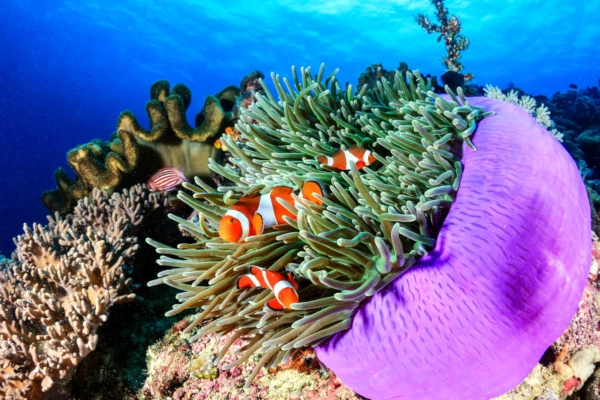
Lembongan Bay is the most sheltered dive site around Nusa Lembongan and is ideal for beginner divers, training dives, and Discover Scuba Diving. With shallow depths, gentle conditions, and a sandy bottom, it’s a calm and colorful place to enjoy the underwater world—perfect for a first diving experience in Bali.
This site is located just in front of the main bay where many snorkel pontoons operate. Despite being close to busy areas, the reef remains surprisingly healthy. The white sand bottom reflects sunlight, making the vibrant corals and fish stand out even more.
You can expect to see clownfish, angelfish, butterflyfish, damselfish, and many juvenile reef fish. Lembongan Bay also offers great chances to spot macro life such as nudibranchs, shrimp, crabs, moray eels, octopus, and cuttlefish. It’s also a popular location for courses like Peak Performance Buoyancy and Fish Identification.
The east coast of Nusa Penida is a hidden gem for scuba diving in Bali, offering some of the most vibrant coral reefs and pelagic encounters around the island. While this area is less visited than the north or west coasts, it rewards experienced divers with unforgettable underwater scenery and rich marine life.
Among the dive sites we visit most often are Karang Sari and Batu Mulapan—two of our favorites for their healthy reefs, diverse topography, and great chances to spot reef sharks, barracudas, and even Mola Mola during the season. These sites usually offer more manageable conditions and are suitable for a wide range of certified divers.
Sampalan is located near the harbor and has become more affected by strong currents and traffic, so we dive there less often. Malibu Point is an advanced dive reserved for confident divers with excellent control, and Batu Abah is part of a protected marine zone, where we only dive for conservation or research purposes.
With its mix of colorful reefs, thrilling drifts, and big fish potential, East Nusa Penida is a fantastic area to explore—when conditions allow and with an experienced guide who knows how to adapt the plan for safety and enjoyment.
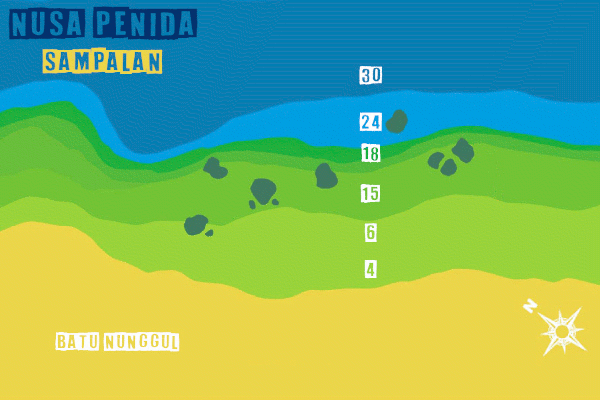
Located near the main harbor on the east coast of Nusa Penida, Sampalan (also known as Batu Nunggul) is a dive site full of coral diversity and colorful marine life. However, due to its proximity to boat traffic and the presence of strong, shifting currents, we dive Sampalan less frequently than other East Penida sites.
When conditions are good, the dive can be very enjoyable. The entry point and route will depend on the current direction and strength, assessed by your dive guide. The underwater scenery features large barrel sponges, soft and hard corals, and a variety of reef fish. Macro lovers may also spot frogfish, nudibranchs, and other hidden critters among the coral heads.
While not our most visited site in East Penida, Sampalan can be a great option on the right day and offers an interesting alternative for those looking to explore beyond the usual routes.
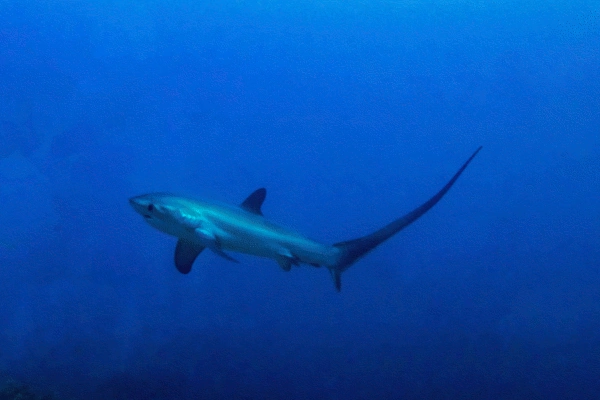
Batu Mulapan is one of our favorite dive sites on the east coast of Nusa Penida. It offers a fantastic mix of vibrant coral reefs, pelagic sightings, and light to strong drift conditions. We dive here regularly due to its healthy reef, and rich marine life.
The dive usually starts on a sloped reef that transitions into a colorful plateau. You’ll glide past dense hard coral formations, including staghorn and lettuce corals, home to countless reef fish. The area is less crowded than other sites, which means a more relaxed and immersive dive experience.
Pelagic encounters are common—giant trevally, tunas, and even Mola Mola during the season (July–October) can make an appearance. We even try early morning dive there with our Nusa Penida dive center guest for Hammerhead shark!
Your experienced guide will assess the conditions on the day and choose the best route, entry point, often keeping the dive within the reef area rather than drifting too far into the blue.

Karang Sari is one of our most frequently visited dive sites in East Nusa Penida, loved for its colorful reefs and reliable conditions. It’s located slightly south of Batu Mulapan and offers a more protected dive experience, making it suitable for a wide range of divers.
This dive site features a broad coral plateau followed by a gentle step-like slope, perfect for exploring at different depths. The reef is teeming with life—you’ll find healthy soft corals, sea fans, barrel sponges, and a great mix of reef fish. The area is also home to macro life like frogfish, nudibranchs, and mantis shrimp, alongside larger marine creatures such as reef sharks, turtles, and the occasional eagle ray or Mola Mola during the right season.
We often dive here when conditions on the West coast are non-favorable, the reef structure offers both beauty and shelter. It’s a great option for divers who enjoy variety—macro, reef life, and pelagic.
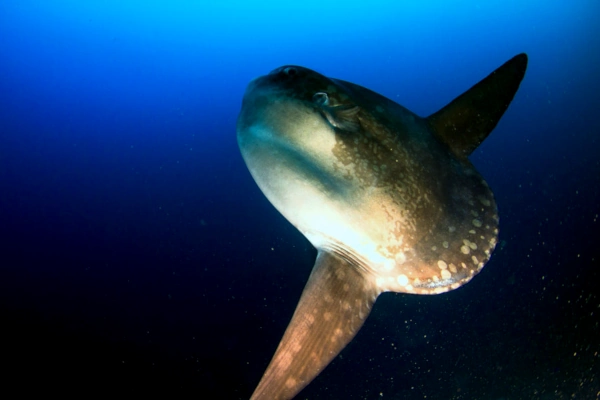
Malibu Point is one of the wildest and most demanding dive sites on the east coast of Nusa Penida. Known for its unpredictable and shifting currents, this site is only for advanced and confident divers. It’s a place where your guide’s experience truly matters, as conditions can change quickly—both before and during the dive.
The dive starts on a beautiful plateau dotted with colonies of staghorn corals. As you move toward the steep slope, the topography becomes more dramatic, offering the perfect backdrop for big pelagic action. Malibu is all about the unexpected—blacktip reef sharks, schools of eagle rays, giant trevally, and during the right season, the famous Mola Mola (ocean sunfish) might appear from the blue.
This is not a site we dive casually. Before going, our guides will carefully evaluate sea conditions and only proceed if everything aligns for a safe and thrilling dive. Malibu is about raw beauty and powerful ocean energy—a true favorite among experienced divers looking for something special.

Batu Abah is one of the most legendary and least accessible dive sites in Nusa Penida. Located on the southeastern tip of the island, this dive site sits within a protected marine reserve, and special permits are required to dive here. We only dive Batu Abah for conservation or research purposes, not for regular fun diving.
When the sea conditions allow, Batu Abah offers a raw and remote underwater landscape that very few divers get to experience. The topography features a steep slope and rocky plateau, home to healthy coral formations and abundant fish life. It’s an area known for strong, unpredictable currents, so dives here must be handled with great care and only with highly experienced divers.
Batu Abah is one of the rare places in Bali where you might encounter oceanic manta rays, giant trevallies, sharks, and of course, the Mola Mola during the right season. The reef is exceptionally well preserved, and the feeling of isolation adds to the site’s mystique.
This is a prestige dive site—rare, wild, and not for everyone—but for those lucky enough to dive it under the right conditions, it’s an unforgettable adventure.
| Type : | Wall, drift, reef |
| Access : | 45 minutes speedboat ride from Sanur beach |
| Coral/bottom : | abundant mostly hard coral, large bommies and coral walls |
| Marine life : | Manta rays, Mola-Mola, other rays, Reef fish, sea-snakes etc |
| Current/conditions : | None to very strong including strong downcurrents at some sites |
| Visibility : | up to 35m |
| Depth : | 10 – 50m+ |
| Experience level : | from complete beginner to advanced |
| Photography : | Wide angle / snapshot (Mantas, Molas) |
Staying in South Bali? Join our daily diving trips or diving package from Sanur to explore the incredible underwater world of the Nusa Islands — including Nusa Penida, Nusa Lembongan, and Nusa Ceningan.
We organize everything for a smooth and safe diving experience. Whether you want to see manta rays, dive into colorful reefs, or search for the legendary Mola Mola (seasonal), this is one of the best scuba adventures in Bali.